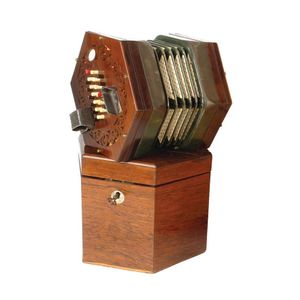George III Coromandel & Rosewood Nesting Tables, 1810
You must be a subscriber, and be logged in to view price and dealer details.
Subscribe Now to view actual auction price for this item
When you subscribe, you have the option of setting the currency in which to display prices to $Au, $US, $NZ or Stg.
- Provenance - A term used to describe the provable history of an antique or work of art, and thus an additional aid to verifying its authenticity. Provenance can have an inflating effect on the price of an item, particularly if the provenance relates to the early settlement of Australia, a famous person, or royalty. Less significant are previous sales of the item through an auction house or dealer.
- George Iii - George III (1738 - 1820) was King of Great Britain and Ireland from 1760 to 1820.
- Rosewood - A dense timber that varies in shade to very light brown to almost black. When rosewood is cut and sanded the colour of the timber will turn black, and after polishing and exposure to daylight, the surface will gradually lighten over time to light brown with black streaks.
The name comes from the odour emanating from the timber when it is planed, sanded or cut.
Rosewood was very popular for use in Victorian furniture in the second half of the 19th century, and at that time most of the rosewood was imported from Brazil. However it also grows in India and Indonesia.
It is used in the sold for chairs and table legs, but for carcase furniture such as side cabinets and bookcases, and for table tops it is always used as a veneer. - Calamander / Coromandel - Calamander wood, also known as coromandel wood or coromandel ebony, is a type of hardwood that comes from the Calamander tree (Diospyros quaesita), which is native to Sri Lanka, India, and Southeast Asia. The wood is known for its dark brown or black colour and its distinctive figuring, which can resemble a snakeskin pattern.
The wood is highly prized for its beauty and durability. It is often used in fine furniture making, particularly in the production of inlaid and marquetry work, as well as in the making of boxes, cabinets, and other decorative items. It is also used in the manufacture of flooring, paneling and other architectural applications.
Calamander wood is a very hard and heavy wood, it has a density of around 1.04 g/cm3. Its density and high natural oil content make it resistant to decay and insects, which is why it is a popular choice for outdoor furniture, flooring and other decorative items.
The wood is also used for turning and carving, but is difficult to work due to its high density and interlocking grain. However, it takes a high natural polish and has a beautiful lustre, which is why it is so sought after.
Due to the high demand and over-exploitation of the natural resources, the calamander tree is now a protected species, and the harvesting and export of the wood is heavily regulated. - Circa - A Latin term meaning 'about', often used in the antique trade to give an approximate date for the piece, usually considered to be five years on either side of the circa year. Thus, circa 1900 means the piece was made about 1900, probably between 1895 and 1905. The expression is sometimes abbreviated to c.1900.
This item has been included into following indexes:
Visually similar items

A Georgian corner cabinet, circa 1830s, a moulded pediment with a dentil motif above a single astragal glazed door opening to three internal shaped shelves, above a slightly extended lower section with a single panelled cupboard embellished with a simple s

14ct yellow gold citrine & diamond necklace, set with 30 chequerboard cut citrines, each separated by 2 diamonds (60 diamonds in total) stamped RJM 14ct (RJM most likely stands for 'Radical Jewelry Makeover' an organisation who believe in ethical mining an

A late Victorian Sedgwick of London rosewood faced and cased concertina, hexagonal form with fret cut panels, rows of various coloured buttons, green leather trim, in fitted rosewood case, with key

A gold flat curb link chain with charms; 18ct gold chain. Chain weight 11g.
